Although the secrets of a long life remain a mystery, there are now over 300,000 centenarians across the globe and the numbers are rising. Most of us will not survive to 100 no matter how many green vegetables we eat, but there is no doubt life expectancy is increasing. In Japan, 2.5 times more adult than baby diapers are sold. Australian life expectancy from birth is among the highest in the world with the average man living to 80.7 and 84.9 for a woman. It assumes no improvement in healthcare which can increase life expectancy further.
The strength of equity markets during 2019 and the start of 2020 saw an increase in valuation premiums in the market resulting in a number of sectors trading at record highs. But the reporting season outlook has been impacted by a slowing global economy, the devastating bushfires across Australia and the coronavirus, elevating the risk profile of the market.
In this first video of our Reporting season series, Lonsec’s Listed Products Portfolio Manager, Danial Moradi, takes an in-depth look at how companies performed over the first two weeks of the reporting season.
Lonsec has partnered with AMP to make its Retirement Managed Portfolios available via MyNorth Managed Portfolio.
The portfolios harness the depth and breadth of Australia’s leading research provider, allowing users to build high-quality retirement solutions incorporating Lonsec’s best investment ideas. Underpinning the portfolios is Lonsec’s strict quality criteria, requiring funds to be rated ‘Recommended’ or higher by its investment research team.
“Our managed portfolios give financial advisers access to investment solutions supported by one of Australia’s largest investment research and consulting teams,” said Lonsec CEO Charlie Haynes.
“Being able to draw on our investment selection and portfolio construction expertise is a real plus, and we’re proud to be able to extend this access via the North platform users.”
Lonsec’s Retirement Managed Portfolios are objectives-based and focused on delivering an attractive and sustainable level of income while generating capital growth through a diversified portfolio of managed investments.
Lonsec offers three Retirement portfolios: Conservative, Balanced and Growth. Each are designed to achieve different risk and investment objectives over various timeframes. They are constructed using a range of funds that play a specific role, such as income generation, capital growth and risk control, and backed by Lonsec’s rigorous governance and review processes.
“Our Retirement Managed Portfolios have been constructed to manage the risks most relevant to investors in the retirement phase,” said Lonsec’s Chief Investment Officer Lukasz de Pourbaix.
“By diversifying across asset classes, managers and return sources, we aim to manage risks such as capital drawdown, which can materially impact the longevity of a retirement portfolio, particularly in the early stages of transitioning from superannuation to the pension phase of investing.”
“We’re very excited to be working with AMP to make these portfolios available to AMP’s North wrap users.”
Inclusion on North further expands the distribution of Lonsec’s Managed Account offering, following its existing availability on the BT, Macquarie, HUB24, Netwealth and Praemium platforms.
Lonsec’s retirement portfolios have been constructed to meet the income and capital objectives of investors in the retirement phase as well as to manage risks that are specifically relevant to retirees.
AMP’s North platform offers advisers flexible and efficient access to a range of investment products, which now include Lonsec’s retirement portfolios, giving advisers the tools they need to meet their clients’ goals.
The outbreak of the coronavirus in over 28 countries has sent shockwaves through global financial markets over the past fortnight with increasing levels of uncertainty and misinformation evident across a number of regions. While there are many unknowns regarding this outbreak, there is likely to be continued disruption to economic activity ahead, which is unlikely to subside until the outbreak is brought under control.
The impact of the coronavirus on equity markets is likely to be multi-faceted with the potential to impact earnings across a numbers of sectors over 2020. While Asian equity markets are likely to take the brunt of the initial impact, the effects are likely to be felt across global markets, noting that previous outbreaks over the last two decades have resulted in short–term equity market corrections within a range of 5-15%.
Implications on the Australian equity market
From an Australian equities perspective, we are likely to see earnings outlook downgrades across a number of sectors, at a time of elevated valuations and a sub-par growth outlook, particularly as we head into the February reporting season. While earnings across the Healthcare, Consumer Staples and Infrastructure sectors should be relatively immune to recent events, based on Lonsec’s initial estimates, 2020 earnings estimates for the Resources (Energy, Iron Ore and Copper), Tourism/Travel and Consumer Discretionary sectors are likely to see significant one-off earnings revisions, capturing the impact of the coronavirus outbreak and the recent bushfires across Australia. However, such downgrades are unlikely to impact the long-term investment thesis for most companies and should be regarded as short-term headwinds, reflecting a series of one-off unfortunate events.
Lonsec’s asset allocation views
From an asset allocation perspective, Lonsec’s multi-asset portfolios remain very well diversified with only a small direct exposure to Chinese equity and bond markets. Consequently, our current focus is on the flow on effects that a sustained slowdown in Chinese growth may have on the domestic growth outlook given our close trading ties. As previously noted, our valuation indicators for Australian equities remain elevated, making them susceptible to a pullback should Chinese authorities’ attempts to stabilise growth fail. We have maintained our slight underweight positions in both global and Australian equities for the time being, however continue to monitor events closely.
While there is a high degree of uncertainty regarding the coronavirus outbreak, Lonsec notes that this event does pose a long “tail risk” for global markets should the outbreak get out of hand. These factors make it a challenging period for investors, where factors other than fundamentals are having a material impact on the trajectory of markets. In such an environment, we believe selective valuation opportunities will present themselves for long-term investors, however ensuring that your portfolio is diversified will be very important in navigating an increasingly volatile market environment.
Happy New Year and welcome back! It has been a tumultuous time for our country and our thoughts go out to those that have lost homes and loved ones due to the bushfires that have engulfed Australia.
Calendar year 2019 saw most asset classes generate very strong returns with many delivering double-digits returns. Australian equities, as measured by the S&P/ASX 300 Index, returned 23.8%, while global equities, as measured by the MSCI World ex Australia Index AUD, returned 27.6% for the year. At the other end of the asset classes spectrum, bonds also posted strong returns with Australian bonds, as measured by the Bloomberg AusBond Composite 0+ Year Index AUD, returning a solid 7.3% for the year. These returns were generated despite concerns over US-China trade tensions, Brexit, arguably high asset prices and mixed economic news.
A key factor contributing to this market strength has been the fact that interest rates appear to be on hold in the US and possibly heading lower in Australia. This is making investing in growth and interest rate sensitive assets, such as property and infrastructure, attractive when compared to holding your money in cash. Additionally, some of the economic indicators that were trending down, such as the PMI (Purchasing Manager’s Index), seem to have stabilised and the consumer seems to be holding up.
In 2020 we are paying particular attention to three key themes:
- Valuations
Asset classes are generally trading at fair to expensive territory with US equities appearing the most expensive based on most valuation measures. While interest rates are low these valuations may be sustainable in the near term. However, we expect that at some point valuations will come back into vogue. Timing turning points is difficult however on a forward-looking basis our expectation would be that ‘expensive’ asset classes will generate lower returns in the future. Based on this we retain our slightly underweight exposure to equity markets heading into 2020 favoring real assets and alternative assets. - The cycle
Much has been written about being late cycle and we think that we are at the later stages of the cycle. There are signs that some economic indicators have stabilised, which markets view favorably. Key things to watch in 2020 will be the consumer and household savings rate, which has been rising, and the possible flow on effect on consumption. - X-factors
Despite strong market returns, 2019 saw bouts of volatility caused by geopolitical issues including the US-China trade tensions. We expect this geopolitical environment to continue in 2020. Furthermore, we have seen geopolitical tensions rise in the Middle East with growing concerns over US-Iran relations. Such events create market uncertainty and market volatility in the short-term.
We wish everyone a prosperous and safe 2020.
For consumers, 2019 was a year best forgotten as negative economic news created an almost perpetual drag on sentiment and global uncertainty resulted in repeated bouts of volatility. But for investors, including Australia’s 15 million super fund members, it was a year that saw a sizeable accumulation of wealth, driven by share market gains as well as some savvy investment decisions by the top-ranking funds.
Even with the high expectations set during a year that saw share markets rally ever higher, several super funds were able to translate this favourable environment into exceptional gains for members.
Topping the leader board in 2019 was UniSuper, whose balanced option delivered a return of 18.4% over the year and is among the top performers over 10 years with a return of 8.9% per annum. Over one year, UniSuper was followed by AustralianSuper – Australia’s largest fund – which returned 17.0% in 2019 and 9.0% over 10 years. However, it’s Hostplus that remains in first place over 10 years with an annual return of 9.2%.
Top 10 balanced options (return over 1 year)
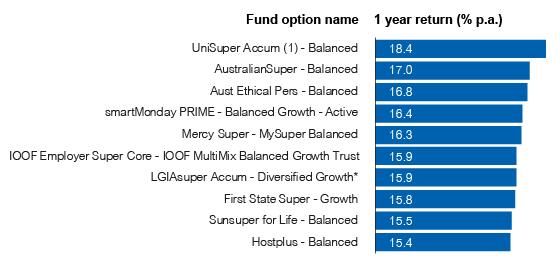
*Interim return
Source: SuperRatings
Top 25 balanced options (return over 10 years)
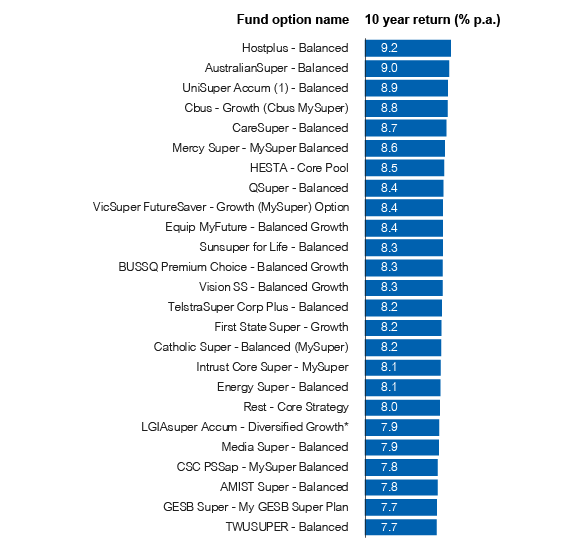
*Interim return
Source: SuperRatings
UniSuper came out on top in a crowded field, in which the top 10 funds delivered an average return of 16.3%. It was a tight race over longer time periods, and while markets have certainly provided a tailwind, there’s no doubt that skilful management plays a role in squeezing out additional returns.
While returns may appear narrowly spread at the top, this hides some significant differences in asset allocation and investment strategies pursued by different funds. What was interesting to see was the diversity of approaches that funds take, even at the top of the leader board. While most funds have benefited from strong equity markets, the nuances among the top performers are where there has been strong value added for members.
In the case of UniSuper, the fund continues to pursue an active management strategy with exposures predominantly to Australian and International Equities, as well as significant cash and fixed interest exposures. Allocations to illiquid assets such as infrastructure and private equity are not a key component of their strategy.
Meanwhile, Hostplus has significant allocations to illiquid assets, with these being a key driver of its performance outcomes for Property, Infrastructure and Private Equity assets. AustralianSuper has also benefited from material unlisted asset exposures, as well as fee savings generated from its in-house investment structure.
Top pension funds
One of the key challenges super funds face is the current low-yield environment, which is making it harder for funds to generate income for members. This challenge is likely to be felt more acutely by those in the post-retirement phase, who rely on the income generated by their pension product to fund living expenses.
In this environment, picking the right pension fund and option can be critical. The below chart shows how capital stable pension options (20–40% growth assets) stack up over 10 years, and while there is some dispersion in the results, every option in the top 25 by performance exceeded the typical CPI plus 3.0% target. AustralianSuper’s Stable option is the best performer, returning 7.6% p.a. over ten years, followed closely by TelstraSuper’s Conservative option and Hostplus’s Capital Stable option.
Top 25 capital stable pension options (return over 10 years)
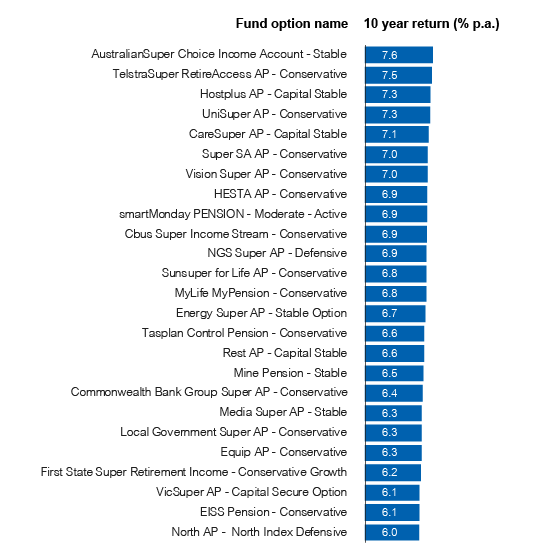
Source: SuperRatings
Understanding risk is critical for consumers
Most consumers can’t define risk, but they know it when they experience it. For superannuation members, risk can mean the likelihood of running out of money in retirement, or not having enough cash to pay for holidays, car repairs, or an inheritance for their kids.
For young members starting out in the workforce, short-term market falls might not matter too much because their investment horizon is relatively long. But for members nearing retirement, the timing of market ups and downs can have a significant effect on the wealth they have available in the drawdown phase.
For a young worker with a relatively low super balance, being exposed to riskier assets is less of a problem – in fact, it can help them accumulate wealth over their working life. However, for members approaching retirement (aged 50 and over), an unexpected pullback in the market can mean the difference between living comfortably and having to cut back in order to get by.
For this reason, it’s important to consider not only the return that a fund delivers but also the level of risk it takes on to achieve that return. In this context, risk means the degree of variability in returns over time. Growth assets like shares may return more on average than traditionally defensive assets like fixed income, but the range of return outcomes in a given period is greater.
The table below shows the top 25 funds ranked according to their risk-adjusted return, which measures how much members are being rewarded for taking on the ups and downs.
Top 25 balanced options based on risk and return
| Fund option name | 7 year return (% p.a.) | Rank |
| QSuper – Balanced | 9.1 | 1 |
| CareSuper – Balanced | 9.8 | 2 |
| Cbus – Growth (Cbus MySuper) | 10.3 | 3 |
| Hostplus – Balanced | 10.5 | 4 |
| BUSSQ Premium Choice – Balanced Growth | 9.6 | 5 |
| Sunsuper for Life – Balanced | 10.0 | 6 |
| Catholic Super – Balanced (MySuper) | 9.4 | 7 |
| HESTA – Core Pool | 9.6 | 8 |
| CSC PSSap – MySuper Balanced | 9.0 | 9 |
| MTAA Super – My AutoSuper | 9.5 | 10 |
| Media Super – Balanced | 9.4 | 11 |
| Intrust Core Super – MySuper | 9.8 | 12 |
| AustralianSuper – Balanced | 10.5 | 13 |
| Mercy Super – MySuper Balanced | 10.0 | 14 |
| Rest – Core Strategy | 9.0 | 15 |
| First State Super – Growth | 9.7 | 16 |
| QANTAS Super Gateway – Growth | 8.3 | 17 |
| TWUSUPER – Balanced | 8.8 | 18 |
| Energy Super – Balanced | 9.3 | 19 |
| Local Government Super Accum – Balanced Growth | 9.0 | 20 |
| AMIST Super – Balanced | 8.9 | 21 |
| VicSuper FutureSaver – Growth (MySuper) Option | 9.8 | 22 |
| Club Plus Super – MySuper | 8.9 | 23 |
| NGS Super – Diversified (MySuper) | 8.9 | 24 |
| LGIAsuper Accum – Diversified Growth* | 8.9 | 25 |
Risk/return ranking determined by Sharpe Ratio
*Interim return
Source: SuperRatings
QSuper’s return of 9.1% p.a. over the past seven years is slightly below the average of 9.7% across the top 10 ranking funds, but it has the best return to risk ratio of its peers, meaning it delivered the best return given the level of risk involved. Funds such as CareSuper, Cbus and Hostplus were able to deliver higher returns, but for a slightly higher level of risk.
Super funds are on track to finish 2019 with the strongest returns in years, defying fears of a market fade in the final quarter. While market conditions have been challenging, investors have not yet succumbed to the negative economic headlines, which has been good news for super funds.
If momentum holds up through the rest of the year, members in the median balanced option will be looking at an annual return of around 15.0% for 2019 – a result not seen since 2013.
According to leading research house SuperRatings, funds have done a good job of managing uncertainty, which has only been exacerbated by global risks and challenging economic conditions at home. But while consumers are feeling the pinch, their super is holding up well.
A rebounding share market saw the ASX 200 Index return 3.3% in November, putting Australian shares on track to deliver a return of around 26.0% for 2019, which would be the highest investors have seen since 2009. This is despite weakness from the major Financials sector, which slipped 2.0% over the month as the major banks were marked down due to the lower interest rate outlook, while Westpac (-13.1%) was the latest to be hit with negative headlines.
Looking at November’s results, the median balanced option returned an estimated 2.0% over the month, with Australian shares contributing 0.6% and international shares 1.0%, bringing the year-to-date return to 14.8%. The median growth option delivered an estimated 2.3% over the month, bringing the year-to-date return to 17.2%.
Over the past five years, the median balanced option has returned an estimated 7.9% p.a., compared to 8.7% p.a. for growth and 4.9% p.a. for capital stable (see table below).
Estimated accumulation returns (% p.a. to end of November 2019)
| YTD</strong | 1 yr | 3 yrs | 5 yrs | 7 yrs | 10 yrs | |
|---|---|---|---|---|---|---|
| SR50 Growth (77-90) Index | 17.2% | 15.2% | 10.5% | 8.7% | 10.4% | 8.6% |
| SR50 Balanced (60-76) Index | 14.8% | 13.4% | 9.3% | 7.9% | 9.3% | 8.0% |
| SR50 Capital Stable (20-40) Index | 8.3% | 8.5% | 5.5% | 4.9% | 5.4% | 5.6% |
Source: SuperRatings
Pensions products have similarly performed well over the course of 2019, with the median balanced pension option returning an estimated 16.3% year-to-date to the end of November, compared to 19.6% for growth and 9.6% for capital stable.
Estimated pension returns (% p.a. to end of November 2019)
| YTD | 1 yr | 3 yrs | 5 yrs | 7 yrs | 10 yrs | |
|---|---|---|---|---|---|---|
| SRP50 Growth (77-90) Index | 19.6% | 17.1% | 11.5% | 9.9% | 11.7% | 9.6% |
| SRP50 Balanced (60-76) Index | 16.3% | 14.9% | 10.0% | 8.5% | 10.2% | 8.8% |
| SRP50 Capital Stable (20-40) Index | 9.6% | 9.4% | 6.3% | 5.7% | 6.2% | 6.4% |
Source: SuperRatings
“We may not have seen the ramp up in shares before Christmas that some were hoping for, but it’s still safe to say that 2019 has been a highly successful year for super funds and their members,” said SuperRatings Executive Director Kirby Rappell.
“It’s been a nervous year for investors, so it’s great to see that super can deliver some much-needed stability and solid returns during this period. There might not be a lot of positive economic news at the moment, but at least super is one story we can all draw some hope from.”
“Since the Royal Commission’s final report at the start of the year, super funds have fought hard to restore members’ trust in the system. We’ve seen good funds responding proactively to the changing regulatory landscape, which has been pleasing. We expect to see an increase in fund mergers in 2020, but it’s important that regulatory responses don’t move us towards a one-size-fits-all approach, which could be detrimental to member outcomes.”
Members must look beyond raw returns
Everyone agrees that funds that aren’t delivering for members have no place in the super system. However, focusing purely on returns as a measure of a fund’s success ignores a range of factors, not least of which is the level of risk involved in generating that return.
As the chart below shows, there is a significant dispersion of risk and return outcomes among different funds. Looking at how balanced options compare over the past five years, there are some producing higher returns than the median option, but many are producing these higher returns by taking on a higher level of risk (measured as the standard deviation of returns).
Risk and return comparison – Balanced (5 years to 30 November 2019)

Source: SuperRatings
When assessing investment performance over time, the top-left quadrant (higher return for lower risk) is what members should generally aim for. Similarly, the bottom-right quadrant (lower return for higher risk) represents the laggard funds. Over any given time period, there will always be funds that outperform and those that underperform.
Looking at past performance can be useful when picking the right fund, but it shouldn’t be the sole criteria. For one thing, past performance is no guarantee of future performance, but there are many factors members should take into account when assessing a super fund, including insurance, governance, member services, and of course fees.
Markets continued their upward trajectory in November. When you look at the returns across key asset classes over the last 12 months most asset classes have generated double digit returns. Growth assets such as equities and listed real assets generated over 20% for the year ending 30 November, while bonds generated high single digit to double digit returns. This has been a great outcome for investors and certainly well above Lonsec’s long-term expected returns for asset classes.
Part of what has fuelled these high returns, post markets getting the wobbles after the US yield curve inverted in August, can be attributed to markets pricing in the avoidance of a recession and the expectations of a potential recovery in growth. We have witnessed such ‘mini-cycles’ in the past, in 2013 and 2016, however what is different this time is that EPS growth is more muted and other factors which contributed to previous mini-cycles, such as the US or Chinese fiscal stimulus, are less likely to have an impact.
So what does this mean for markets? We think markets may experience a short-term upswing as the ‘mini-cycle’ plays out. We have therefore slightly adjusted our dynamic asset allocation tilts deploying some of the excess cash in our portfolios towards Australian equities. Our overall asset allocation continues to have a defensive skew with the objective of diversifying the portfolios by asset type and investment strategy. This positioning reflects our broader view that asset prices are stretched and that while some economic indicators have stabilised, we believe we are closer to the end of the cycle.
The question no-one wants to ask is – Why are APRA collecting, interpreting and then publishing information in the public domain? The answer is simple – They shouldn’t be!
Instead of regulating, APRA are now trying to play the shame game through their just released heatmaps. But there is a real risk that some of those shamed will be the wrong funds. As the founder of SuperRatings, Jeff Bresnahan says, “The problem is that no one in the industry wants to tell the regulator that they have got it wrong.”
Effectively, APRA is putting into circulation data which analyses just parts of a super fund, not the whole. By ignoring things like Governance, Advice, Insurance and Member servicing structures, consumers are not being provided with the whole picture.
As Bresnahan says, “While conflicts of interest were identified as a major issue in superannuation during the Royal Commission, it seems ironic that APRA has deliberately avoided reporting any measurement of a Fund’s Governance structure”.
In an industry which carries inherently conflicted Directors, it would appear that Governance is ignored in favour of more easily assessable information. Whether such omissions create any legal liabilities for APRA in the future remains debatable.
As a result, APRA continues its foray into unchartered territory. This is not the first time APRA have got it wrong. They have been producing performance tables for over a decade. Unfortunately, the performance tables were flawed from a usefulness perspective, in that they don’t reflect the performance of a super fund’s investment options. However, they continue to produce them and in doing so confuse and possibly mislead Australians.
And so it continues with the heatmaps. Having reviewed the heatmap methodology, SuperRatings is of the opinion that their release into the public domain may create more questions than they answer and that consumers could well be influenced into products that are inappropriate for them.
Aside from the bigger question of why APRA is publishing such data, there remain a number of problems with the methodology adopted. Critically, APRA appears to ignore implicit asset fees when measuring net investment performance. As Bresnahan says, “This methodology can easily overstate the net benefit a member receives. Similarly, a low-cost investment option with high administration fees creates the very real possibility of consumers investing monies in cheap investment options that have no chance of outperforming the relevant index over any time period, whilst getting slugged high administration fees.”
Investment analysis since the onset of the Superannuation Guarantee in 1992 has shown that all implicit fees and performance must be analysed together on an actual net of fees basis. Many leading funds, in terms of balanced option performance, have had higher allocations than the average fund to traditionally more expensive asset classes such as infrastructure, private equity and unlisted property. These asset classes have continually outperformed cheaper alternatives.
It’s only when all actual fees and returns are combined that the range of results is clearly evident in dollar terms, as the following graph indicates. The graph shows the disparity of net earnings on a $50,000 starting balance (and $50,000 salary) with SGC contributions mapped over both the last 3 and 10 years. Notably, many of the funds that added the most value, over both the short and long term, invested into the more expensive asset classes. Driving people into low-cost options will come at the expense of future earnings, something that taxpayers will ultimately have to bear.
Net benefit trend analysis (over 3 and 10 years)
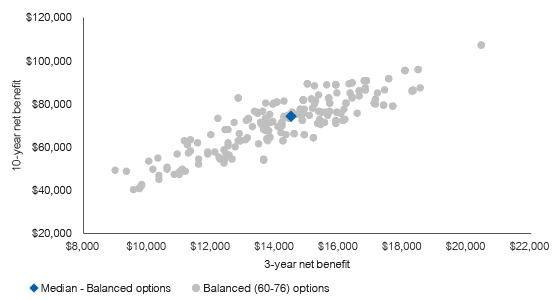
Source: SuperRatings
And the anomalies continue. The heatmaps are judging funds on short term performance over just 3 and 5 years. Whilst it will be claimed this is necessary due to the limited performance history of MySuper products, it should be noted that most funds have been around for over 25 years and that their default option provides an accurate MySuper proxy.
As Bresnahan said, “Given super is a key plank of Australia’s economic future, it seems counter-intuitive for the Government’s regulator to not measure funds over a more realistic period. Certainly, it is commonly accepted that 7, 10 and 15 year performance analysis is best practice given the long term (60 years plus) nature of superannuation membership.”
Again, a consumer moving funds due to seeing a 3-year performance gap, mid-way through an economic cycle, will no doubt be moving for the wrong reasons.
The way forward
Bresnahan says, “Australians are not stupid, but they remain frustratingly unengaged with their superannuation.” This problem remains the real challenge for much of the industry. APRA’s endeavours are admirable, but questionable at the same time. He goes on to say, “A regulator should set the structure under which funds need to operate. The morphing of this regulatory process into public comparisons leaves it open to being seen as stepping across the line. One wonders what they are actually trying to achieve by moving into this public domain.”
If APRA must continue down this path, then SuperRatings suggests that they need to concentrate on the whole picture, rather than isolated parts therein. This should, aside from earlier mentioned issues, also include:
- Regulations to enable consistent fee disclosures, including the inequitable use of tax deductions and transparency to members;
- The disclosure of risk within portfolios, both via the assumptions within their growth/defensive disclosures and accepted risk measures;
- Compulsory disclosure of major asset holdings;
- Moving members into go-forward products and removing legacy structures;
- Continued rationalisation of member accounts; and
- Increased focus on the decumulation phase and the optimisation of the alignment with retiree objectives.
Identifying poorly run funds is not difficult and APRA would be well aware of them. A series of simple measures such as the non-public fee analysis shown below, when combined with other key assessments, quickly shows those funds who have spent the past few decades masking conflicts of interest at the expense of members.
When it costs a fund over $1,200 to run every account (versus a median of $300) or a fund’s operating expenses as a percentage of assets are over two and a half times the median, then those funds bear further scrutiny. Similar work can be done across Investments, Governance, Administration and Insurance, to name a few. By putting together the whole picture, the poor funds are very quickly exposed.
Operating expenses versus size and members
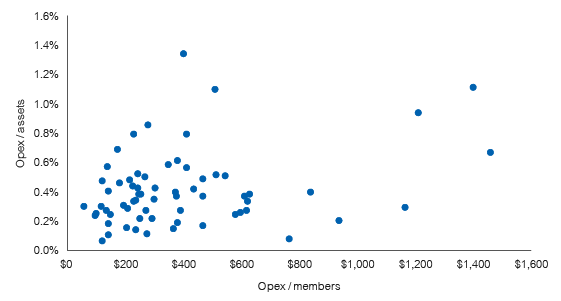
Source: SuperRatings
But it’s not all gloom and doom for the process. Importantly, after 14 years of industry debate, APRA has finally made a call on what constitutes a growth asset and what constitutes a defensive asset. The growth/defensive debate remains loud within the industry but with APRA’s call of Australian Unlisted Property and Australian Unlisted Infrastructure being 25% defensive, at least there is a starting point. SuperRatings suspect this will not however be the final position.
Certainly, APRA’s front foot involvement with data will give cause for reflection for all super funds, as the funds review their results and assess whether it has any implications for their future.
SuperRatings continues to watch the evolution of the market and continues to monitor funds on their effectiveness in responding to key challenges. We look forward to seeing whether the heatmaps evolve over time and remain broadly supportive of APRA’s underlying intentions. However, we underline that this remains only part of the picture and that the risk of making providers look alike is real. In an environment where innovation is needed, regulatory settings to support innovation are vital to ensure a vibrant industry that thrives into the future resulting in better outcomes for members.
Release ends
We welcome media enquiries regarding our research or information held in our database. We are also able to provide commentary and customised tables or charts for your use.
For more information contact:
Jeff Bresnahan
Founder & Chairman
Tel: 1300 826 395
Jeff.Bresnahan@superratings.com.au
Kirby Rappell
Executive Director
Tel: 1300 826 395
Kirby.Rappell@superratings.com.au
Super funds are off to a positive start in the December quarter, regaining momentum following a rocky September and paving the way for double-digit returns for the 2019 calendar year.
While markets have come under pressure in recent months, super funds have once again proved they are up to the task of navigating the significant uncertainty in markets, geopolitics, and the global economy.
Super fund returns held up well in October, despite weakness from Australian shares and signs of softer economic growth globally. The major financials sector has come under pressure due to constrained lending, lower net interest margins, and continued fallout from the Royal Commission. IT shares also suffered a dip as investors questioned the lofty valuations of Australia’s local tech darlings.
According to SuperRatings’ estimates, the median balanced option returned a modest 0.3% in October, but the year-to-date return for 2019 is sitting at a very healthy 12.5%. The median growth option has fared even better, returning 14.4%, while the median capital stable option has delivered a respectable 7.1% to the end of October.
Over the past five years, the median balanced option has returned an estimated 7.6% p.a., compared to 8.3% p.a. from growth and 4.7% p.a. from capital stable (see table below).
Estimated accumulation returns (% p.a. to end of October 2019)
| YTD | 1 yr | 3 yrs | 5 yrs | 7 yrs | 10 yrs | |
| SR50 Growth (77-90) Index | 14.4% | 11.9% | 10.1% | 8.3% | 10.1% | 8.5% |
| SR50 Balanced (60-76) Index | 12.5% | 10.5% | 8.9% | 7.6% | 9.1% | 7.9% |
| SR50 Capital Stable (20-40) Index | 7.1% | 6.8% | 5.0% | 4.7% | 5.3% | 5.6% |
Source: SuperRatings
Estimated pension returns (% p.a. to end of October 2019)
| YTD | 1 yr | 3 yrs | 5 yrs | 7 yrs | 10 yrs | |
| SRP50 Growth (77-90) Index | 16.4% | 13.3% | 11.2% | 9.4% | 11.4% | 9.5% |
| SRP50 Balanced (60-76) Index | 13.8% | 11.7% | 9.8% | 8.3% | 9.9% | 8.7% |
| SRP50 Capital Stable (20-40) Index | 8.3% | 7.7% | 5.9% | 5.5% | 6.0% | 6.4% |
Source: SuperRatings
“This year has provided further solid evidence of the ability of super funds to deliver for their members through a challenging market environment,” said SuperRatings Executive Director Kirby Rappell.
“Whether it’s the US-China trade conflict, the weaker economic outlook, falling interest rates, or the rolling Brexit saga, there’s been a lot for funds to take in. This has been a real test of their discipline and ability to manage risks on the downside. Growing wealth in this environment while protecting members’ capital is a tall order, but they have managed it well.”
Shifting asset allocation key to managing risk
One of the most important trends in the superannuation industry is the broadening of members’ investments across different asset classes. Over the past five years, super funds have shifted away from Australian shares and fixed income and moved a higher proportion of funds into international shares and alternatives (see chart below).
Change in asset allocation (2009 to 2019)
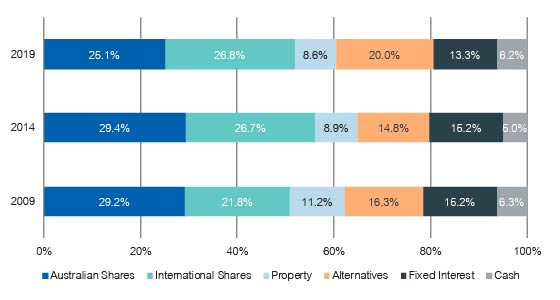
Source: SuperRatings
The shift to alternatives is significant and has been the subject of debate within the industry. Alternatives include private market assets and hedge funds, which despite the negative connotations can provide an important source of diversification and downside protection when markets take a turn for the worse.
These assets tend to be less liquid, but they can play an important role for funds looking to generate income while managing risks for their members in a world characterised by low yields and growing uncertainty. However, funds should be clear about their alternatives strategy and the risks they could potentially add to members’ portfolios.
“This shift in asset allocation is in part being driven by the low interest rate environment, which has prompted super funds to reach for yield by allocating to alternatives and other less liquid assets,” said Mr Rappell.
“This isn’t necessarily a bad thing, and it may in fact result in a more robust asset allocation, but it’s something members should be aware of. Alternatives can help protect capital under certain market conditions, but they can also be used to boost returns by taking on some additional risk. We generally think the shift to a broader asset allocation is positive, but funds should not be complacent in ensuring risk is appropriately managed.”
Important information: Any express or implied rating or advice is limited to general advice, it doesn’t consider any personal needs, goals or objectives. Before making any decision about financial products, consider whether it is personally appropriate for you in light of your personal circumstances. Obtain and consider the Product Disclosure Statement for each financial product and seek professional personal advice before making any decisions regarding a financial product.

